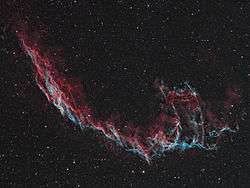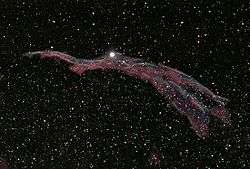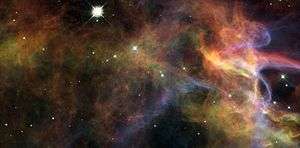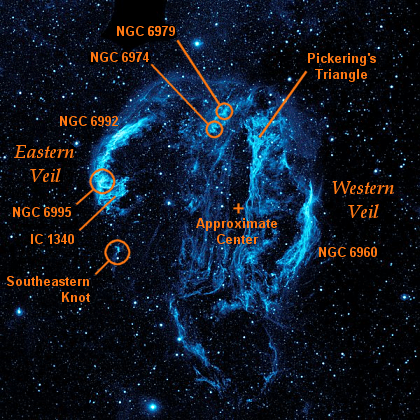Veil Nebula
| Diffuse nebula | |
|---|---|
| supernova remnant | |
|
Western Veil nebula | |
| Observation data: J2000.0 epoch | |
| Right ascension | 20h 45m 38.0s[1] |
| Declination | +30° 42′ 30″[1] |
| Distance | 1470[2] ly |
| Apparent magnitude (V) | 7.0 |
| Apparent dimensions (V) | 3 degrees (diameter) |
| Constellation | Cygnus |
| Physical characteristics | |
| Radius | 50 ly |
| Designations | NGC 6960,[1] 6992,[1] 6995,[1] 6974, and 6979, IC 1340, Cygnus Loop, Cirrus Nebula,[1] Filamentary Nebula,[1] Witch's Broom Nebula (NGC 6960),[3] Caldwell 33/34 |
The Veil Nebula is a cloud of heated and ionized gas and dust in the constellation Cygnus. It constitutes the visible portions of the Cygnus Loop (radio source W78, or Sharpless 103), a large but relatively faint supernova remnant. The source supernova exploded some 5,000 to 8,000 years ago, and the remnants have since expanded to cover an area roughly 3 degrees in diameter (about 6 times the diameter, or 36 times the area, of the full moon). The distance to the nebula is not precisely known, but Far Ultraviolet Spectroscopic Explorer (FUSE) data supports a distance of about 1,470 light-years.[2]
The Hubble Space Telescope captured several images of the nebula. The analysis of the emissions from the nebula indicate the presence of oxygen, sulfur, and hydrogen. This is also one of the largest, brightest features in the x-ray sky.
September 24, 2015 new images and videos of the Veil Nebula were released,[4] with an explanation of the images.[5]
Components
In modern usage, the names Veil Nebula, Cirrus Nebula, and Filamentary Nebula generally refer to all the visible structure of the remnant, or even to the entire loop itself. The structure is so large that several NGC numbers were assigned to various arcs of the nebula.[6] There are three main visual components:
- The Western Veil (also known as Caldwell 34), consisting of NGC 6960 (the "Witch's Broom", "Finger of God",[7] or "Filamentary Nebula"[7]) near the foreground star 52 Cygni;
- The Eastern Veil (also known as Caldwell 33), whose brightest area is NGC 6992, trailing off farther south into NGC 6995 (together with NGC 6992 also known as "Network Nebula"[8]) and IC 1340; and
- Pickering's Triangle (or Pickering's Triangular Wisp), brightest at the north central edge of the loop, but visible in photographs continuing toward the central area of the loop.
NGC 6974 and NGC 6979 are luminous knots in a fainter patch of nebulosity on the northern rim between NGC 6992 and Pickering's Triangle.[9][10]
Observation

The nebula was discovered on 1784 September 5 by William Herschel. He described the western end of the nebula as "Extended; passes thro' 52 Cygni... near 2 degree in length", and described the eastern end as "Branching nebulosity... The following part divides into several streams uniting again towards the south."
When finely resolved, some parts of the image appear to be rope-like filaments. The standard explanation is that the shock waves are so thin, less than one part in 50,000 of the radius,[11] that the shell is visible only when viewed exactly edge-on, giving the shell the appearance of a filament. Undulations in the surface of the shell lead to multiple filamentary images, which appear to be intertwined.
Even though the nebula has a relatively bright integrated magnitude of 7, it is spread over so large an area that the surface brightness is quite low, so the nebula is notorious among astronomers as being difficult to see. However, an observer can see the nebula clearly in a telescope using an OIII filter (a filter isolating the wavelength of light from doubly ionized oxygen), as almost all light from this nebula is emitted at this wavelength. An 8-inch (200 mm) telescope equipped with an OIII filter shows the delicate lacework apparent in photographs, and with an OIII filter almost any telescope could conceivably see this nebula. Some argue that it can be seen without any optical aid except an OIII filter held up to the eye.
The brighter segments of the nebula have the New General Catalogue designations NGC 6960, 6974, 6979, 6992, and 6995. The easiest segment to find is 6960, which runs behind the naked eye star 52 Cygni. NGC 6992/5 are also relatively easy objects on the eastern side of the loop. NGC 6974 and NGC 6979 are visible as knots in an area of nebulosity along the northern rim. Pickering's Triangle is much fainter, and has no NGC number (though 6979 is occasionally used to refer to it). It was discovered photographically in 1904 by Williamina Fleming (after the New General Catalogue was published), but credit went to Edward Charles Pickering, the director of her observatory, as was the custom of the day.
In fiction
Gallery
-

Eastern Veil (NGC 6992/95)
-

Eastern Veil Detail (NGC6992)
-

Pickering's (Fleming's) Triangular Wisp
-

Western Veil (NGC 6960)
-

Detail of the Veil Nebula.
-

Portion photographed by Hubble Space Telescope
-

Veil Nebula observed by Hubble Space Telescope.[1]
-

Cygnus Loop with labels
- ^ "Revisiting the Veil Nebula". Retrieved 1 October 2015.
See also
References
- 1 2 3 4 5 6 7 "SIMBAD Astronomical Database". Results for Veil Nebula. Retrieved 2007-01-02.
- 1 2 William Blair. "Piercing the Veil: FUSE Observes a Star Behind the Cygnus Loop Supernova Remnant". FUSE Science Summaries. Retrieved 2010-11-29.
- ↑ "Astronomy Picture of the Day". NGC 6960: The Witch's Broom Nebula. Retrieved 2007-01-02.
- ↑ "HubbleSite - NewsCenter - Hubble Zooms in on Shrapnel from an Exploded Star (09/24/2015) - Related Links". hubblesite.org. Retrieved 2015-09-25.
- ↑ Blair, William (September 2015). "The Cygnus Loop/Veil Nebula Hubble Space Telescope" (PDF). http://hubblesite.org/. External link in
|website=(help) - ↑ Tirion; Rappaport; Lovi (1991) [1987]. Uranometria 2000 1. Richmond, VA: William–Bell, Inc. p. 120. ISBN 0-943396-14-X.
- 1 2 Tom Trusock, "Small Wonders: Cygnus ...", [section] "The Veil", Cloudy Nights Telescope Reviews
- ↑ NGC 6960, 6979, 6992, 6995: The Veil Nebula
- ↑ "NGC/IC Project". Results for NGC 6974. Retrieved 2010-12-03.
- ↑ "NGC/IC Project". Results for NGC 6979. Retrieved 2010-12-03.
- ↑ William Blair. "Cygnus Loop HST Photo Release". William Blair Homepage at Johns Hopkins University. Retrieved 2010-11-29.
Coordinates: ![]() 20h 45m 38s, +30° 42′ 30″
20h 45m 38s, +30° 42′ 30″
External links
| Wikimedia Commons has media related to Veil Nebula. |
- Australian Astronomical Observatory – IC 1340, photograph by David Malin
- spacetelescope.com – "Uncovering the Veil Nebula", with several Hubble Space Telescope photos
- APOD (2010-11-19) – Nebulae in the Northern Cross, showing Veil Nebula to scale in Cygnus
- APOD (2010-09-16) – Photo of the entire Veil Nebula
- APOD (2009-12-01) – NGC 6992: Filaments of the Veil Nebula
- APOD (2003-01-18) – Filaments in the Cygnus Loop
- APOD (1999-07-25) – Shockwaves in the Cygnus Loop (and underlying HST photo)
- Bill Blair (Johns Hopkins University) – Cygnus Loop HST Photo Release
- Bill Blair (Johns Hopkins University) – Photo combining optical and X-ray data
- Bill Blair (Johns Hopkins University) – Overview photo of Cygnus Loop and Veil Nebula
- The Veil Nebula on WikiSky: DSS2, SDSS, GALEX, IRAS, Hydrogen α, X-Ray, Astrophoto, Sky Map, Articles and images
- Veil Nebula at Constellation Guide
| ||||||||||||||
